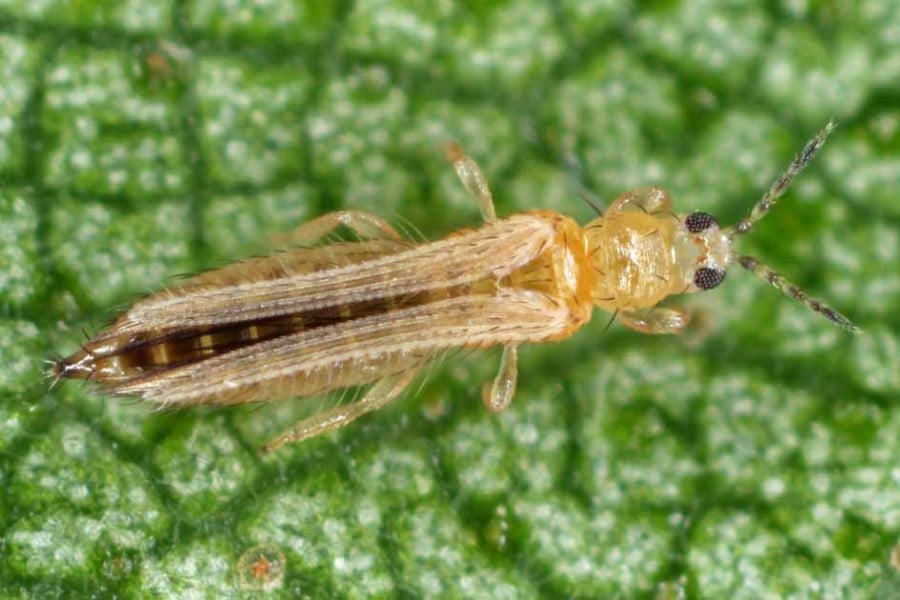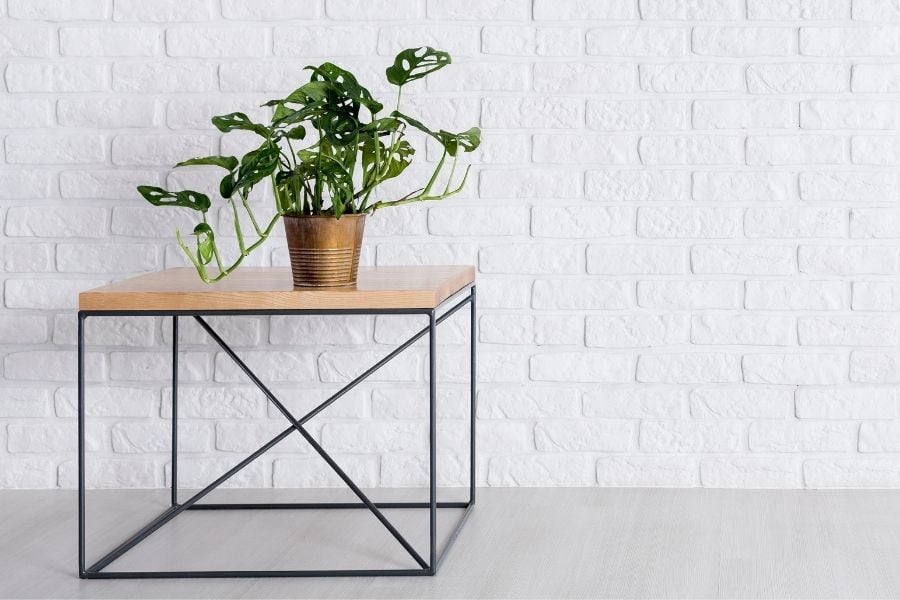What are thrips?
Thrips are tiny green bugs that feed primarily on plant sap and cause damage to indoor plants and outdoor plants alike.
Thrips damage flowers, vegetables, fruit trees, shrubs, and really any organic plant material they can find to feed on. Thrips attack by inserting their mouthparts into the leaves or stems of a plant and then suck up fluid.
What do thrips look like?
Thrips range in size from 1 / 50- to 1 / 25-inches long and often have a white, dark yellow, or brown color. Adult thrips have silvery wings but they are not naturally for flying very far. They use their wings to glide between leaves in search of more food and a place to lay their eggs and rear their larvae.

Adult thrips can also transmit viruses from one plant to another. So it is really important to inspect your whole garden for damage, to get rid of thrips, and to treat any infested plants.
As they are notoriously difficult to get rid of, the harm caused is often hard to notice until it’s too late.
How do you know if your plant has thrips?
Thrips are very small insects and are a challenge to find on both indoor and outdoor plants. Their damage to leaves is characterized by silvery patches that resemble “scattered salt crystals.” The silver color does not show up until thrips have been feeding for some time (typically days or even weeks).
This makes it difficult to see and treat infestations early in their development. But without any control or prevention, the plant will be left weaker, and growth is stunted.

After some time, thrips damage the plant so much that the leaves and flowers become a browny-yellow color. At this point, the problem can’t be ignored.
What are the first steps to get rid of thrips?.
In order to treat your plants correctly, the first step is to inspect and search for thrips by hand. If any of your indoor or outdoor plants have yellow, brown, or off-green discoloration then you have a pest problem.

Thrips can’t really fly or jump very far, so they must make their way from plant to plant in search of new food sources and shelter.
For gardening projects outside, you should check any surrounding areas where there could potentially be an infestation, such as fallen leaves on the ground or other pest-attracting debris nearby (such old wood and leaf piles).

For houseplant problems, look around your house for any infested zones. Plants near open windows, or in humid areas will likely attract the tiny devils so check these first. Setting up sticky traps near your indoor plants will catch any pests passing by. While on the traps, you can visually identify your bug problem.
Life cycle and population levels of thrips
The life cycle of thrips is quite interesting because they do not require mating in order to reproduce. The female thrips lay their eggs into flowers and other plant parts without any help from males.
The females can produce up to 80 offspring that hatch within days or weeks depending on how warm it gets outside.

After becoming nymphs, many will pupate near soil before emerging as adults once again with feathery wings. They then fly back onto your plants for reproduction!
This small insect goes through a rapid metamorphosis, and this is why they often have 12-15 generations per year. In warm weather, the entire cycle from egg to adult may take as little as 16 days!
How long does it take before a thrip infestation becomes visible?
Thrips populations grow quickly – but you’ll usually start noticing signs of thrips on your garden and indoor plants within about two weeks of an initial outbreak.
After the leaves on your outdoor and indoor plants are showing signs of damage, the infestation may have left the area already.

Thrips hatch after as little as 16 days (depending on the temperature) so if you have seen any adults around your house, on leaves, or in the garden then there’s no time to waste cleaning them up now!
7 tips to get rid of thrips now
There are some natural tricks you can use to attack thrips in your garden or house without needing to spray chemical pesticides or harm the environment!
1. Flushing thrips
One popular technique for getting rid of thrip populations is called “flushing”. Thoroughly clean your plants and surrounding areas with a strong spray of water to remove any insects from the leaves.

Thrips can’t survive well in really wet conditions, by dwindling their numbers you can protect your plant life and health a little longer.
You’ll need more than one spray of water though if you want to completely eradicate these insects!
2. Taping
Another technique is called “taping”. Take heavy-duty tape (such as packing tape) and cover it around each plant stem several times.
Thrips are attracted to stalks and other stems where there’s plenty for them to eat – but by sealing off those food sources using a naturally slippery barrier, you’re giving thrips nowhere to go.

Tape will stop thrips from moving in and out of the plant, so you can be sure that they won’t keep coming back. Thrip population growth slows down when there’s nowhere for them to go!
Please note: this is not a 100% foolproof solution because some thrip adults find ways around the tape over time.
3. Sheltering plants
Other people have had success with another technique called “sheltering”. A thrip egg requires a lot of moisture to hatch, so as long as you keep your plant dry it can be difficult for thrips populations to grow.

You may find that some areas around your home or garden are wetter than others – if this is the case then move plants from those high humidity spots into drier locations.
Their offspring will die before hatching when placed in an area where they’re not able to get enough water!
4. Weathering
Thrips also have a difficult time with windy conditions – by placing potted plants near areas where there’s plenty of air movement you’re both ensuring they won’t find food sources AND reducing risk from potential infestations spreading rapidly!

Placing plants in areas where the ground is higher up can help too. Thrip eggs don’t have a chance when they’re exposed to wind!
5. Time heals all
You can also try waiting for populations to die out on their own. They will die off eventually as long as you provide them with few food sources – BUT it takes time and patience before the infestation dwindles away completely.

6. Use predatory insects to get rid of thrips
As a last resort, gardeners with an infestation of plant thrips might consider releasing commercially available beneficial insects that prey on the eggs and larvae of thrips before they can become adults.
Minute pirate bugs are one such predator (feeding off egg clusters in high numbers), but other species like ladybugs or lacewings also have their uses.

This is especially effective for greenhouses where pests thrive due to warm temperatures year-round.
7. Use neem oil- an insecticide alternative to remove thrips
One of the best tips is to spray neem oil on the leaves and flowers of the infested plant. Neem oil has been used for generations of gardeners to get rid of thrips. It is a biologically relatively safe and natural ingredient that kills thrips quickly.

The Importance of Integrated Pest Management (IPM)
Integrated pest management (IPM) is a way of controlling pests without using any harsh chemicals like insecticidal soap by integrating several different strategies together.
It is especially important choose a natural method of removal if you are treating a problem indoors as other beneficial animals such as dogs and cats might get sick with insecticide spray.

Thrips populations can be managed with a few simple adjustments of your plants, as well as by researching and following specific IPM guidelines for any plants you have in the garden!
Using pesticides to remove thrips
Gardening without insecticidal chemicals is both natural and avoids some unintended future consequences. Some gardeners might resort to using pesticides, but this isn’t recommended for a few reasons.

Thrips can become immune to chemical agents if they’re exposed too often, and the long-term effects of pesticide use on human health are still unknown – so it’s best not to take any risks!
How can I avoid thrip damage?
The best method to avoid thrip damage is through prevention.
Thrips are attracted to stressed plants because those plants release excess nutrients into the air around them; bringing those struggling plants back to prime health is one of the best methods that will benefit the whole garden.

Trimming the foliage of houseplants and garden plants near ground level is a fantastic way to prevent thrips. Thrips can often be found in this area as it’s a prime spot for them to feed and lay eggs without being seen.
Before planting anything amend soil with compost which contains bacteria that predators eat as well as fungi that produce toxins against pests like thrips and grubs).
When is the worst season for thrips?
Thrip infestations also tend to peak during humid summers and dry winters – when plants are less able to recover from the pests’ damage.

Thrips can be difficult to control in hot weather because their populations grow much quicker than in winter.
How planters prevent thrips
The best way to protect your plants from thrip infestation is by keeping them in a planter!
This method helps because the soil in planters is easier to examine for signs of insect activity. Pots are also easy to move around to quarantine plants or to bring them indoors for closer inspection.

For big plants that you can’t bring indoors, using a planter will add another hurdle for pests to climb over. Every tactic is greatly appreciated by your plants when getting rid of thrips!
It can be a nuisance to deal with thrips on plants. But fret not! We have the perfect planters that will protect your plant from these pesky insects, and look stylish at the same time. Check out our range of planters today and find one that is right for you (or buy two!)
